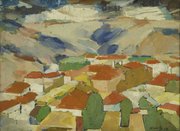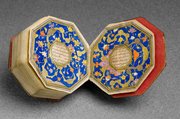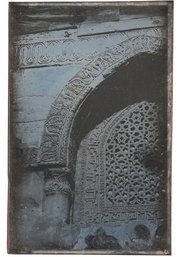
Rectangular Iznik Tile
Museum of Islamic Art
- Title:
- Rectangular Iznik Tile
- Production place:
- Iznik
- Date:
- 1560
- Period:
- Ottoman
- Title:
- Rectangular Iznik Tile
- Production place:
- Iznik
- Date:
- 1560
- Period:
- Ottoman
- Material:
- Fritware, Pigment, Glaze
- Technique:
- Underglaze painting, Glazing
- Dimensions:
- 21.0 × 38.3 cm
Iznik pottery is named after the town of Iznik, in western Anatolia (modern day Turkey), where it was initially made. The earliest evidence of Iznik production occurred during the reign of the Ottoman Sultan Mehmed II (r. 854-886 AH/1451-81 CE), whose appreciation for fine blue and white Chinese Ming porcelains inspired potters to start making similar ceramics. Iznik tile production was revitalised a century later, when the Ottoman Sultan Suleiman the Magnificent (r. 926-974 AH/1520-66 CE) began commissioning tiles to decorate his newly built mosque in Istanbul, which resulted in expanding the market and its production. Panels started being produced to decorate important buildings.
This tile dates to the 10th century AH/mid-16th century, a period when new colours and patterns were introduced. It is a rectangular border tile decorated with three bold blue, red and turquoise floral sprays with serrated edges, interspersed with arabesques against a white ground. Only the central spray is seen in full, with two half flowers decorating the top and bottom portion, flanked by a rope-edge. The colours used in this tile are identical to those used in the mosque of Rustem Pasha (built. 968/970 AH/1561-2 CE), suggesting that this tile could have been used in another major construction of the same period.



